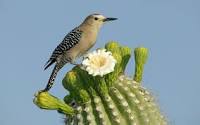This Month’s ‘Cover Girl’ is the Arizona’s Cactus Wren.
 The Cactus Wren is the state Bird of Arizona. The cactus Wren welcomes the Coast Guard Auxiliary and others to its home state. This local character is much less shy than most others in the wren family and is the first to introduce Arizona Boating & Watersports/Western Outdoor Times’ new birding section: ‘For The Birds.’
The Cactus Wren is the state Bird of Arizona. The cactus Wren welcomes the Coast Guard Auxiliary and others to its home state. This local character is much less shy than most others in the wren family and is the first to introduce Arizona Boating & Watersports/Western Outdoor Times’ new birding section: ‘For The Birds.’
The Cactus Wren (Campylorhynchus brunneicapillus) is the largest North American wren, and is 18–23 cm (7-9 inches) long.
Unlike the smaller wrens, the Cactus Wren is easily seen. It has the loud voice characteristic of wrens. The Cactus Wren is much less shy than most of the family.
Its marked white eye stripe, brown head, barred wings and tail, and spotted tail feathers make it easy to identify. Like most birds in its genus, it has a slightly curved bill. There is little sexual dimorphism.
The Cactus Wren primarily eats insects, including ants, beetles, grasshoppers, and wasps. Occasionally, it will take seeds and fruits.
Foraging begins late in the morning and is versatile; the cactus wren will search under leaves and ground litter and overturned objects in search of insects, as well as feeding in the foliage and branches of larger vegetation.
Increasing temperatures cause a shift in foraging behavior to shady and cooler micro-climates, and activity slows during hot afternoon temperatures. Almost all water is obtained from food, and free-standing water is rarely used even when found (Udvardy 1994; Ricklefs 1968; McCarthey 2000).
The Cactus Wren is native to the Southwestern United States southwards to central Mexico. It is a bird of arid regions, and is often found around yucca, mesquite or saguaro; it nests in cactus plants, sometimes in a hole in a saguaro, sometimes where its nest will be protected by the prickly cactus spines of a cholla or leaves of a yucca.
Arizona’s Cactus Wren form permanent pair bonds, and the pairs defend a territory where they live all through the year.
For more reading: Arizona’s Cactus Wren Introduces New Birding Section


































The photo above is NOT of a Cactus Wren but of an adult female Gilded Flicker (Colaptes chrysoides).